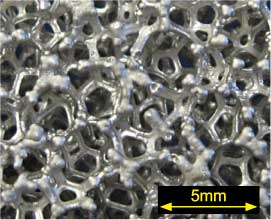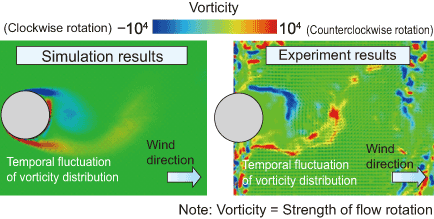1. Simulation-based demonstration of aerodynamic noise reduction through application of porous material
- The RTRI performed simulation and wind tunnel experiments to demonstrate that aerodynamic noise can be reduced through stable airflow formation by applying porous material to allow air suction and blowing into/out of the material.
Development centered on wind tunnel experimentation demonstrating that aerodynamic noise from train structures such as pantographs (which are difficult to design with smooth shapes due to functional restrictions) can be reduced by between 1 to 3 dB by applying a porous material with open cells (Fig. 1) onto their surface. However, since the principles of reducing aerodynamic noise were not always clear, it was necessary to determine variables such as the ideal position for porous material application and effective pasting methods, etc. through trial and error in wind tunnel experiments.
Accordingly, simulation was performed by modeling the flow field around a cylinder to which porous material was applied. The results indicated that stable flow with little fluctuation can be achieved through air suction by porous material at the front of the object and air blowing at the lateral face. The mechanism of reducing aerodynamic noise by pasting porous material was thus demonstrated(Figs. 2, 3).
Additionally, combining flow field simulation using another model (in which the porosity and thickness of the porous material are set as parameters) with simulation of aerodynamic noise evaluation based on vortex variations allowed the identification of more rational and effective pasting positions and pasting methods for porous material.
 Fig. 1 Porous material with open cells
Fig. 1 Porous material with open cells Fig. 2 Vorticity without porous material
Fig. 2 Vorticity without porous material Fig. 3 Vorticity and flow velocity with porous material
Fig. 3 Vorticity and flow velocity with porous material